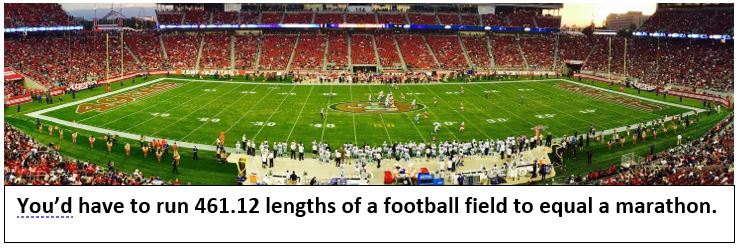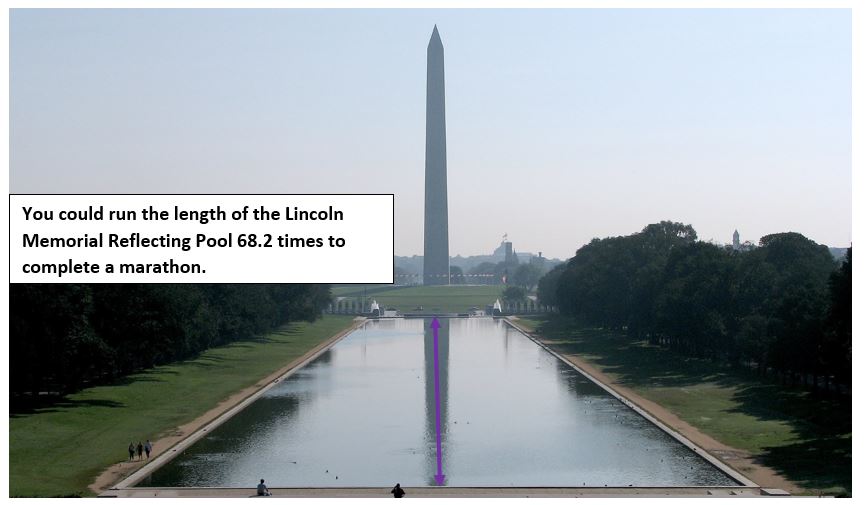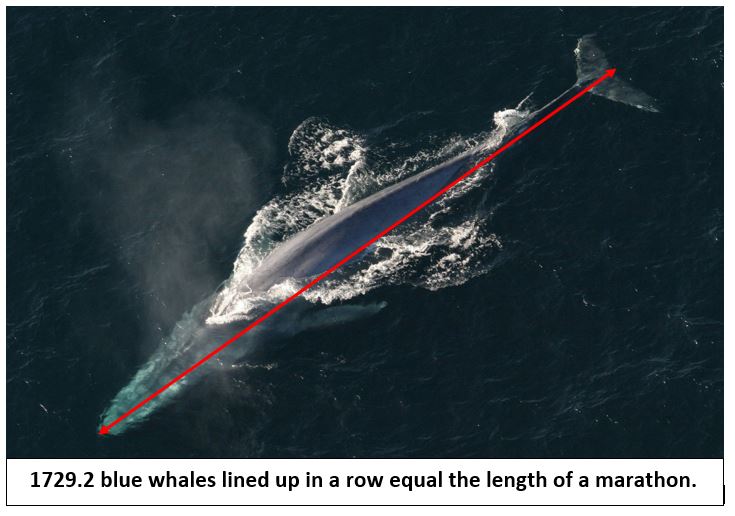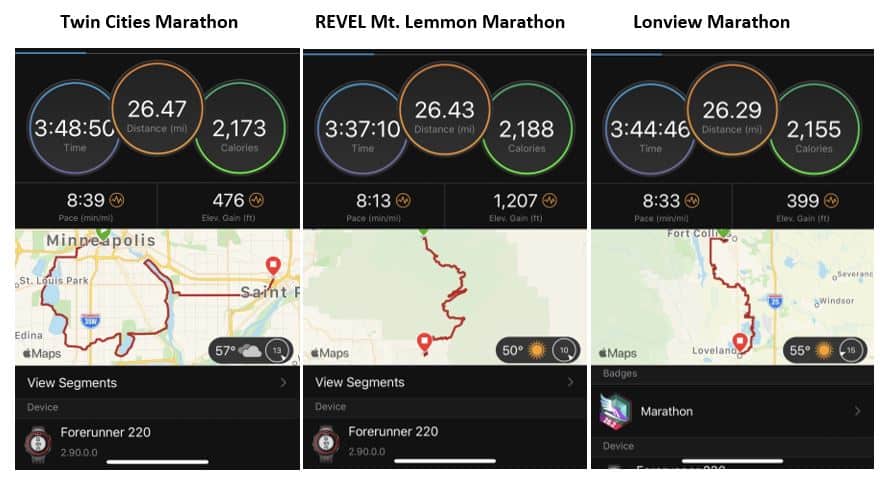As someone who’s been running for 20 years, it’s easy for me to forget that not everyone is up on the lingo of the sport. When I tell people I have a marathon coming up, I think most people realize it’s quite a long distance, but unless they’re distance runners themselves, I don’t think they know exactly how many miles it actually is. Just like 5k and 10k have little meaning to non-runners, until you or someone you know is running a marathon, you probably have little idea the distance.
So, how long is a marathon? A marathon is 26.2 miles long, or 42.2 kilometers. If you run a marathon in the U.S. it’s almost always measured in miles; anywhere else in the world will usually be measured in kilometers. You’d have to complete 105.5 laps around a standard 400 meter track to reach that distance.
If you’re thinking that sounds like an awfully long way, you’d be right. Which is why less than 1% of the population will actually choose to ever run one. Having a hard time wrapping your head around exactly how long that really is? I have some comparisons below to help you out.
How long is a marathon…Let’s Compare
If we want to get perfectly exact, the marathon is 26 miles 385 yards or 42.195 kilometers. Usually people will just round and either say “26.2 miles” or “42 kilometers.” Or if you’re most people, you might just say it’s “way too long.”
But, not to me. The incredible achievement of completing a marathon is what makes me love it so much.
But let’s get back to that length thing.
If you’re not a runner, cyclist or avid walker, even understanding how much distance is covered within a mile might be lost on you. Which makes sense! I am personally really bad at having a frame of reference for 100 feet, for example, because it’s just not something I really utilize. But because I run between 1-2 thousand miles every year, I know exactly how long a mile is.
So if that’s you, let’s put this in terms of something that you may be more familiar with.
Marathon distance comparison for sport fans…
You would need to run the length of a football field 17.6 times to reach a 1 mile. So to get to a marathon we’ll multiply 17.6 x 26.2. This gets us to just over 461 lengths of a football field. It really sounds crazy when you think about it that way…

Marathon distance comparison for history fans…
The Lincoln Memorial Reflecting Pool in Washington D.C. is 2,029 feet in length (you may remember the scene in Forrest Gump where Jenn-ayyy runs towards Forrest and they embrace in the Reflecting Pool in case you’ve never been…) This means you would need to run its length 2.6 to equal a mile. To get to the full marathon distance of 26.2 miles, you would increase that to going back and forth along the pool about 68.2 times.

Marathon distance comparison for nature fans…
A blue whale, the longest animal in the world, is about 80 feet long. Therefore, you’d have to line up 66 whales to reach a mile, requiring about 1,729 blue whales end-to-end to reach the distance of a marathon.

Hopefully one of those comparisons gives a bit more meaning to you when you think about how long a marathon is.
Another thing you can do to really get a feel for how lonnnnng the distance really is, is get in your car and set the trip meter to zero. Drive one mile, and then consider what it would be like to run that distance back and forth over 25 more times. Or better yet, just drive for 26.2 miles and imagine running that. Sounds fun, right?!
All You Can See in the Distance of a Marathon
It doesn’t matter where you run your marathon, the amount of ground covered during an official marathon will always be 26.2 miles (42 km). This became the standard distance set by the International Amateur Athletic Federation (IAAF) in May 1921.
The London Marathon is 26.2 miles, the Boston Marathon is 26.2 miles, and the New York City Marathon is 26.2 miles. And all those small-town or back country trail marathons, if measured correctly, will be the exact same distance. (Just expect them to be measured in kilometers if you run one outside the U.S.)
What IS different in each marathon is what you get to see during the long distance.
Though difficult, one of the most exciting parts about running a marathon is being able to see practically an entire city’s most well-known sights all on foot in the span of one morning.
In New York City, the marathon covers all 5 boroughs: Staten Island, Brooklyn, Queens, The Bronx, and Manhattan.
In London, marathon runners get to run across the London Bridge, take in the infamous Tower of London and run by the London Eye, Big Ben, and Buckingham Palace.
And at the Marine Corps Marathon, held in Washington D.C., runners are able to take in America’s rich history by starting at the Pentagon and Arlington National Cemetery, continuing through Georgetown and the National Mall and finally finishing at the Marine Corps War Memorial.
The marathon distance may be intimidating to many, but if you choose your race wisely, it’s amazing what you can see in the amount of ground covered.
When the Marathon is Supposed to be 26.2 Miles, but Isn’t
Ok, so I know I already said that every marathon (not the same as ultramarathons) should measure 26.22 miles. Then why would they ever be anything but?
Well, if you’ve run a marathon yourself and used a GPS watch, chances are very high that your watch showed that you went a distance farther than 26.2 miles. I’ve provided 3 different marathon finishes from my Garmin below to demonstrate this:

So did the marathon organizers do a poor job of measuring their marathons since all of these are a bit longer than they should be? Not at all…this happens almost every time. Why is that?
Just Run LAH! gives a good explanation on how race courses are measured. Essentially, a calibration course is used (one they already know is the correct marathon distance) to calibrate a bicycle. Once this step is completed, the calibrated bicycle is then used to measure the new race course. This is done multiple times, not just once. Here’s an important point: the calibration bicycle must take the shortest route possible on the course. This is to ensure that no runner will run a distance shorter than the intended distance (in our case, a marathon).
What this means is that as a runner, if you are able to run the shortest route possible along the course, AND your watch is 100% accurate, your watch will register a 26.22 finish. However, in a marathon, this is extremely hard to do.
Why is it so hard to run the “shortest possible route” of a marathon?
Weaving in and out of other runners, jumping up on a sidewalk, taking too wide of a turn, and pulling over to grab water can all add distance to your race. Though it’s not much, doing these things multiple times during a race as long as the marathon adds up. And then instead of running 26.2 miles, your ran 26.5 instead. This happens frequently – and more so in races with lots of twists and turns.
Is it frustrating when your watch reads 26.2 miles and you still haven’t reached the finish line? Of course. But it is for the best. In 2017, the PLC Milwaukee Marathon was 4,200 feet (over 3/4 of a mile) too short, and was no longer able to be used to qualify for the Boston Marathon. Wouldn’t that be devastating?! Even if you weren’t trying to qualify for Boston, maybe you thought you got a PR, but didn’t. Trust me when I say, you want your marathon to be a little bit long instead of a little bit short.

Why the Marathon is 26.2 Miles
A lot of people wonder why the marathon isn’t just a perfect 26 miles (or even a perfect 42 kilometers for that matter). Why is the extra 385 yards necessary? Well, there IS a reason for it…sort of.
I explain this in depth in my article, “How the Marathon Became 26.2 Miles,” but here is the short version.
It’s difficult to know how much of the story is fact, when parts of stories told over time get embellished to make them more exciting. But according to legend, Phidippides, a Greek messenger, is said to have run 25 miles from Marathon to Athens to deliver a battle victory message (after previously running over 140 miles in the days prior). Many say he collapsed in death…whether that’s true is largely debated.
What we know as the modern marathon does stem from that bit of history, with some tweaking. The first Olympics held in Athens, Greece mirrored Phidippides run at 40 km (about 1.5 miles shy of the marathon we know today.) This was how long the first Boston Marathon was, too.
It wasn’t until the London Olympics in 1908 that the marathon actually become 26 miles, 385 yards. There really was no rhyme or reason, according to the New York Times, other than that they wanted the marathon to start at Windsor Castle and end at the Olympic Stadium in such a way that made for easy viewing by the Queen. The final distance ended up being more than the original marathon, and it stuck.
The 26.22-mile (42.2 km) distance became officially official at the 1924 Paris Games.
And through the years, runners keep coming back to the grueling distance to see if they have what it takes to make it every step. With a mileage as high as a marathon, then length of time it takes a runner to finish a marathon can be the difference of hours.
How Long Does it Take to Run the Length of a Marathon
Once a person finds out how long a marathon is, their next question is usually how long that takes someone to complete.
The truth is that there is quite a wide range for how long it takes someone to complete a marathon which I cover in my post, “How long does it take to run a full marathon?”
The current records for the marathon are:
Men: Eliud Kipchoge ran a 2:01:39 at the Berlin Marathon in 2018.
Women: Brigid Kosgei ran 2:14:04 at the Chicago Marathon in 2019.

The record holder times are insanely fast. Even clocking a time under 3 hours (for either male or female) puts a runner in the tippy top percentile compared to all other runners.
Typically, runners will complete a marathon within 4 – 5 hours.
According to Marastats, the average male marathon runner is 40 years old and completes a marathon in 4:10:10; the average female marathon runner is 36 years old running an average time of 4:39:09. Many runners will take over 5 hours to run all 26.2 miles.
Because the marathon is such a long distance, and runners’ abilities vary widely (as does the amount of training they complete before toeing the starting line), the difference of finish times between runners can be hours. But MOST runners will complete a marathon between 4 and 5 hours.
People can also choose to walk a marathon. At a 16-minute mile walking pace, it would take about 7 hours to complete the marathon.
There are many factors that go into running a faster marathon time, but ultimately it comes down to the quality of the training. If you’re looking to train for a marathon, a great place to start is to get a good plan in place and you find several here.
Related FAQ:
How long is a half marathon? A half marathon is exactly half the distance of a marathon. Therefore, they are always 13.1 miles (21.1 km) long. But to be clear, running a marathon isn’t like running two half-marathons. Marastats shows that on average, runners will run around 11 minutes slower in the second half of their marathon. This is because the level of exertion required builds mile after mile.
How long is an ultramarathon? There isn’t just one specific distance for an ultramarathon. A race is referred to as an ultramarathon if it’s any longer than 26.2 miles. Some common ultramarathon distances are 50k, 50 miles, 100k, and 100 miles. Whereas marathons are typically road races, ultramarathons will often be completed on technical trails.
How long should your longest run be when you train for a marathon? You should, at a minimum, run at least one 20 or 21-mile run in training before your marathon. I typically run at least three long runs in the 20-22 mile range. Because these runs are so long, it’s really important to map these ahead of time to know exactly where you’re headed.







